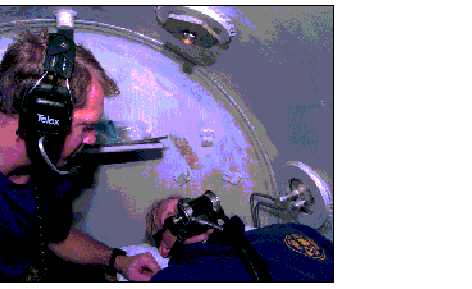21-18 Change A
U.S. Navy Diving Manual—Volume 5
Residual symptoms from AGE/DCS
Carbon monoxide or cyanide poisoning
Smoke inhalation
Medical hyperbaric oxygen therapy
This table may also be recommended by the cognizant Diving Medical Officer
when initially treating a severely injured patient whose medical condition
precludes long absences from definitive medical care.
21-5.5
Tending the Patient. When conducting a recompression treatment, at least one
qualified tender shall be inside the chamber. The inside tender shall be familiar
with all treatment procedures and the signs, symptoms, and treatment of all
diving-related disorders.
21-5.5.1
DMO or DMT Inside Tender. If it is known before the treatment begins that
involved medical aid must be administered to the patient, or if the patient is
suspected of suffering from arterial gas embolism, a Diving Medical Technician or
Diving Medical Officer should accompany the patient inside the chamber.
However, recompression treatment must not be delayed.
21-5.5.2
Use of DMO. If only one Diving Medical Officer is present, the Medical Officer’s
time in the chamber should be kept to a minimum because effectiveness in
directing the treatment is greatly diminished when inside the chamber. If periods
in the chamber are necessary, visits should be kept within no-decompression limits
if possible.
21-5.5.2a
Non-Diver Inside Tender - Medical. Non-diving medical personnel may be quali-
fied as Inside Tenders. Qualifications may be achieved through Navy Diver Inside
Tender PQS. Prerequisites: Current diving physical exam, conformance to Navy
physical standards and diver candidate pressure test.
Figure 21-1. Inside Tender

